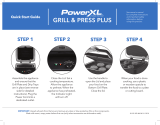
N C
M Y
USING THE GLASS-CERAMIC HOB
Radiant plates
All the radiant plates are equipped with automatic
thermostat; the front lh radiant plate has an adjustable
thermostat.
Automatic radiant plates
The knobs do not have fixed positions.
To switch on the radiant plates, turn the knob to position
12. Once the required temperature has been reached,
turn the knob to the required setting for cooking.
Observe the recommendations in the table.
Automatic start radiant plate
This function is on the front lh radiant plate. The
automatic thermostat on this radiant plate is activated
when the knob is se t anywhe re b etwee n 1 and 7. To
avoid the risk of fat fires at higher temperatures the
thermostat function is not active on between positions 8
and 12. The thermostat automatically switches from high
starting temperature to lower holding temperatures as
cooking proceeds so there is no need to turn the knob
from t he starting position to a lower heat position. If you
wish t o use t his functio n, positio n the knob between 1
and 7 and pull it gently outwards. If the knob is
inadvertently pulled outwards or if you have set the
function and want to cancel it, reset the knob to 0. If you
select the wrong setting, just correct it by repositioning
the knob on the required setting. Starting temperature
will be automatically adapted to the new setting.
Double radiant plates
By switching on the second element, the surface area of
the rear and front left radiant plates can be extended.
For this purpose, turn the control knob fully to the right
(position
X
x
).
Normal radiant plate knob
Now return the knob to the require d posit ion. This
knob functions in the same way as described in t he
previous heading “Automatic start radiant plate”
Heat setting table
Setting
Function
X
x
Switching on the second element
(Double radiant plate only)
12
Boiling large quantities of water;
pasta.
11-12 Chips; meat dishes such as stew.
10-11
Croquets; fillet of steak, steaks,
breaded meat.
9-10
Meat: scallops, cutlets etc., omelettes,
meatballs, roasts
8-9
Tender meat, sausages, liver, eggs,
fritters
5-7
Large portions, single course meals,
soups.
4-6 Boiled potato es, minestr one.
3-5 Boiled vegetables, stew.
3-5 Rice pudding
2-4
Rice and milk based foods, small
quantities of potatoes and
vegetables; warming pre-cooked
food.
1-2
Omelettes, scrambled egg, sauces,
hollandaise sauce; for warming ,
melting butter, chocolate and
gelatine.
0 Residual heat only, radiant plate is off.
Double radiant plate knob
33
33




















